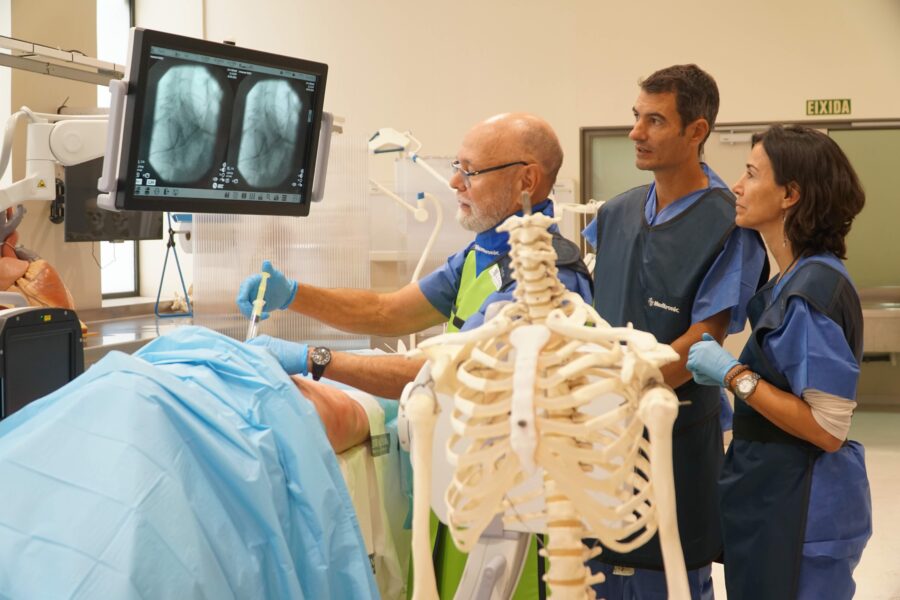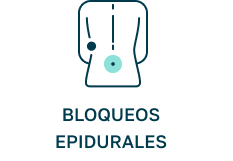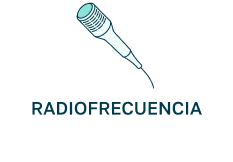Epidural blocks and radiofrequency for sciatic pain treatment

Sciatic pain is a condition that can significantly affect the quality of life of those who suffer from it. Fortunately, there are non-surgical treatment options that can relieve pain and restore function without the need for surgery. Among them, epidural blocks and pulsed radiofrequency have proven to be highly effective in cases where conventional treatments have not been sufficient.
Epidural blocks: How do they work?

Epidural blocks consist of the administration of local anesthetics and corticosteroids into the epidural space in order to reduce inflammation and relieve nerve root compression.
Transforaminal epidural blocks: more precision and effectiveness
Among the different types of epidural blocks, the transforaminal epidural block is considered the most selective and effective, since it allows the medication to be administered directly to the affected area, achieving a higher concentration of the drug in the involved nerve root.
Advantages of transforaminal epidural block:
- Greater precision in the application of the medication.
- Rapid pain relief by reducing radicular inflammation.
- Use of lower doses of drugs compared to other approaches.
- Allows accurate diagnosis of the nerve root responsible for the pain.
This procedure is especially useful in patients with lateralized or foraminal disc herniation, where the radicular compression is more focused.
Pulsed radiofrequency: pain modulation without nerve damage

Pulsed radiofrequency (RFP) is a minimally invasive technique that modulates nerve fiber activity without generating significant thermal injury. Its mechanism of action is based on the application of energy pulses in the dorsal root ganglion (DRG), which alters pain perception without affecting the nerve structure.
Benefits of pulsed radiofrequency
- It can relieve pain for up to six months or more.
- Lower risk of side effects compared to other procedures.
- Neurological modulation without nerve ablation.
- Especially indicated for patients with persistent radicular pain and chronic radiculopathy.
When combined with a transforaminal epidural block with corticosteroids, pulsed radiofrequency enhances its anti-inflammatory effect and provides longer lasting pain relief.
Conclusion
Epidural blocks and pulsed radiofrequency represent two effective and safe therapeutic options for the treatment of sciatic pain. The choice between one or the other will depend on the medical evaluation and the individual response of each patient. These techniques allow pain control without the need for surgery, improving the quality of life of patients with chronic sciatica.

Member No.: 46-3203399
Centers:
Dr. Jorge Orduña Valls is a specialist in Anesthesiology, Resuscitation and Pain Management, and serves as National Medical Director of MIVI Salud, in addition to being Director of the Pain Unit at its headquarters in Valencia.
- He has more than ten years of experience in reference units both nationally and internationally.
- Among his training highlights: Doctoral thesis with Cum Laude mention in 2020 (University of Santiago de Compostela) , European Diploma in Pain Medicine (EDPM) awarded by European Pain Federation (EFIC) in 2017.
- He completed training stays in the USA (e.g. at the Millennium Pain Center in Bloomington, Illinois) and at centers in Miami, Germany and France.
- He is an expert in interventional techniques for pain: radiofrequency, rhizolysis, nerve blocks, etc.
- In research, he has published relevant papers, for example the study “The Nerve to Vastus Medialis as a Target for Treating Chronic Medial Knee Joint Pain: An Ultrasound-Based Anatomical Localization Study” in the journal Pain Medicine (2025) together with other specialists in the field.